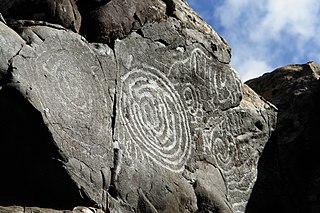Chijoraji or Chijoragi is a name given to the infant Jesus carried in the hand of the Virgin of Candelaria (called by the Guanches Chaxiraxi) in Tenerife. Chijoraji is the name the aboriginal Guanches applied to this representation of Christ.
Chijoraji or Chijoragi is a name given to the infant Jesus carried in the hand of the Virgin of Candelaria (called by the Guanches Chaxiraxi) in Tenerife. Chijoraji is the name the aboriginal Guanches applied to this representation of Christ.

The Guanche were the historic indigenous inhabitants of the Canary Islands in the Atlantic Ocean some 100 kilometres (60 mi) west of the North African coast. They spoke the Guanche language. Believed to have been related to Berber languages of North Africa, it became extinct in the 17th century after the islands were colonized.
Guanche is an extinct language that was spoken by the Guanches of the Canary Islands until the 16th or 17th century. It died out after the conquest of the Canary Islands as the Guanche ethnic group was assimilated into the dominant Spanish culture. The Guanche language is known today through sentences and individual words that were recorded by early geographers, as well as through several place-names and some Guanche words that were retained in the Canary Islanders' Spanish.
Spanish mythology refers to the sacred myths of the cultures of Spain. They include Galician mythology, Asturian mythology, Cantabrian mythology, Catalan mythology, Lusitanian mythology and Basque mythology. They also include the myths and religions of the Celts, Celtiberians, Iberians, Milesians, Carthaginians, Suebi, Visigoths, Spaniards and Roman and Greek mythology.
Benahoare was the native Guanche name for the Spanish island of La Palma, one of the Canary Islands. Prior to its conquest by the Castilians, completed in 1493, the island had been divided into 12 cantons or lordships. The last Guanche lord to submit to European rule was Tanausu. Its name is said to mean "my land."

The Canary Islands have been known since antiquity. Until the Spanish colonization between 1402 and 1496, the Canaries were populated by an indigenous population, whose origin was Amazigh from North Africa.
Abora is the name of an ancestral solar deity of La Palma and a traditional god of the Guanches.
Canary Islanders, or Canarians, are the people of the Canary Islands, an autonomous community of Spain near the coast of northwest Africa. The distinctive variety of the Spanish language spoken in the region is known as habla canaria or the (dialecto) canario. The Canarians, and their descendants, played a major role during the conquest, colonization, and eventual independence movements of various countries in Latin America. Their ethnic and cultural presence is most palpable in the countries of Uruguay, Venezuela, Cuba and the Dominican Republic as well as the U.S. territory of Puerto Rico.
A Tibicena, also known as Guacanchas, was a mythological creature of the Guanches, pre-Hispanic inhabitants of the Canary Islands. Tibicenas were imagined to be demons or genies who had the bodies of great wild dogs with red eyes, covered by long, black fur. They lived in deep caves inside the mountains.

The Virgin of Candelaria or Our Lady of Candle (Tagalog: Mahal na Birhen ng Candelaria, popularly called La Morenita, celebrates the Virgin Mary on the island of Tenerife, one of the Canary Islands. The center of worship is located in the city of Candelaria in Tenerife. She is depicted as a Black Madonna. The "Royal Basilica Marian Shrine of Our Lady of Candelaria" is considered the main church dedicated to the Virgin Mary in the Canary Islands and she is the patroness saint of the Canary Islands. Her feast is celebrated on February 2 and August 15, the patronal feast of the Canary Islands.

Museo de la Naturaleza y Arqueología (MUNA), is a museum-based in Santa Cruz de Tenerife, Tenerife,. It contains many significant archaeological finds and is considered the best repository of objects from the Pre-Castilian Canary Islands. The museum also houses significant paleontological, botanical, entomological, and marine and terrestrial vertebrate collections, and is considered the best Natural Library of the Canary Islands.

Chaxiraxi is a goddess, known as the Sun Mother, in the religion of the aboriginal Guanche inhabitants of the Canary Islands. Chaxiraxi was one of the principal goddesses of the Guanche pantheon. She was associated with the star Canopus.
Achuguayo is the god of the Moon in Guanche religion in Tenerife. He was the duality of Magec. He was also called the "Father of Time", as he was in charge of regulating time.
Achuhucanac is the rain god in Guanche religion in Tenerife, identified with the Supreme God (Achamán). Its name comes from: ašu_hu_kanak Guanche language that means "that is in the rain" or "that who is in the rain".
Maxios or "Dioses Paredros" were benevolent minor gods or genies in the Guanche in Tenerife; domestic spirits and guardians of specific places. These were thought to be mediators between humans and Chaxiraxi, the great celestial mother.

The Archaeological Museum of Puerto de la Cruz is a small archaeological museum located in the town of Puerto de la Cruz. One of the most important local museums, it offers an archival collection comprising more than 2,600 specimens of the aboriginal Guanche culture, and a document collection named after researcher Luis Diego Cuscoy.

The conquest of the Canary Islands by the Crown of Castile took place between 1402 and 1496 and described as the first instance of European settler colonialism in Africa. It can be divided into two periods: the Conquista señorial, carried out by Castilian nobility in exchange for a covenant of allegiance to the crown, and the Conquista realenga, carried out by the Spanish crown itself, during the reign of the Catholic Monarchs.

The Church of the Guanche People is a religious organisation, founded in 2001 in the city of San Cristóbal de La Laguna, Tenerife, Canary Islands, Spain. Its goal is to revive and spread the traditional religion of the indigenous Guanche people who occupied the islands at the time of Castillian conquest.

The Cave of the Guanches, or Archaeological area of the Cave of the Guanches, is an important archaeological site located in the north of the island of Tenerife.
The Caves of Don Gaspar is an important archaeological site located in the north of the island of Tenerife.
Kehf el Baroud, sometimes mistakenly spelled Kelif el Boroud, is an archaeological site in Morocco. It is located to the south of Rabat, near Dar es Soltan.